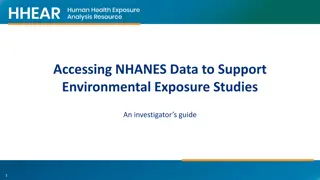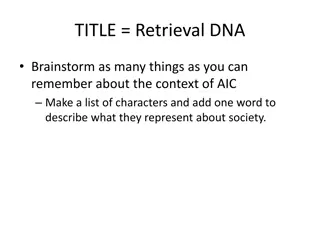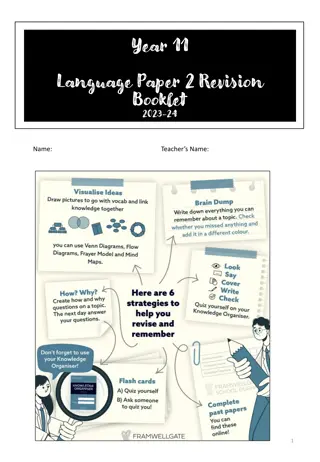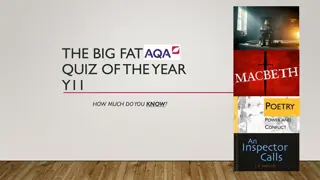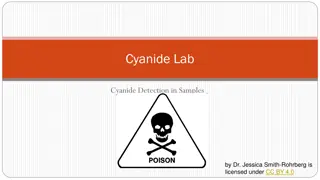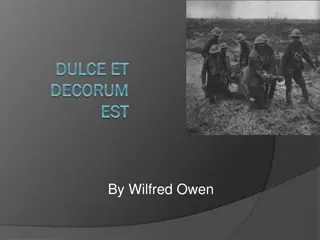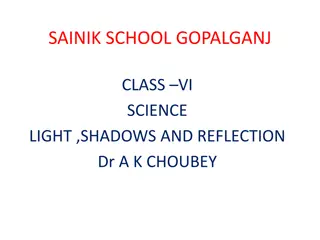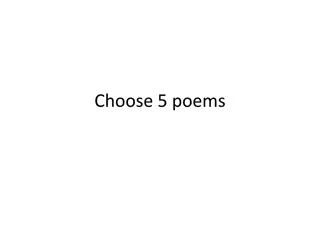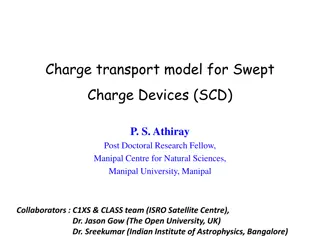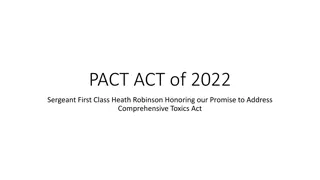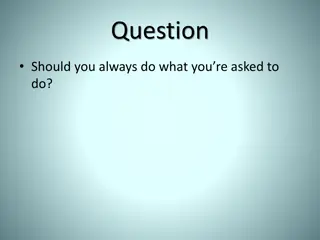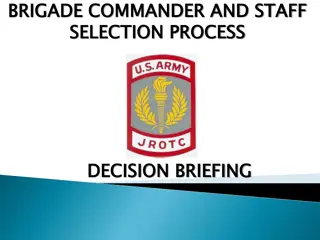War Poetry Reflections: The Charge of the Light Brigade and Exposure
In this reflective analysis, the heroic portrayal of soldiers in Tennyson's "The Charge of the Light Brigade" and the haunting realities of war depicted in Wilfred Owen's "Exposure" are explored. Through vivid imagery and metaphorical language, these poems capture the courage, sacrifice, and suffering experienced by soldiers during wartime. The context of the poets' lives adds depth to the understanding of their works, shedding light on the stark contrast between the noble ideals of war and the harsh realities faced by those on the front lines.
Download Presentation

Please find below an Image/Link to download the presentation.
The content on the website is provided AS IS for your information and personal use only. It may not be sold, licensed, or shared on other websites without obtaining consent from the author. Download presentation by click this link. If you encounter any issues during the download, it is possible that the publisher has removed the file from their server.
E N D
Presentation Transcript
The Charge of The Light Brigade fill the gaps mission to other As horse die option Cannons Valley die following told back into must they Death have orders are prepared no do Tennyson in his Crimean War poem The Charge of the Light Brigade presents the death of the men as heroic, brave and noble. The men are charging on ______ _________ towards The _____ of ________ which has biblical allusions as if they are on a holy _______, ________ _ ____ and ___ __ _____ _______. The metaphor creates the effect that they will ______ because they are going ________ a valley, which is an area that is surrounded by _________ . They are ____________ ________ as the pronoun he said implies that they ______ __ ___ _____ _____ _______. EXTENSION Write a sentence explaining the context
The Charge of The Light Brigade fill the gaps mission to other as horse die option Cannons Valley die following told back into must they death have orders are prepared no do Tennyson in his Crimean War poem The Charge of the Light Brigade presents the death of the men as heroic, brave and noble. The men are charging on horse back towards The Valley of Death which has biblical allusions as if they are on a holy mission, prepared to die and have no other option. The metaphor creates the effect that they will die because they are going into a valley, which is an area that is surrounded by Cannons . They are following orders as the pronoun he said implies that they must do as they are told. Tennyson, who was poet laureate, wrote the poem after seeing a newspaper report to honour the bravery of the men who fought so bravely, with little chance of survival.
The Charge of the Light Brigade In your own words, explain what you think the poem is about.
Context: Exposure Born in 1893. Enlisted in the army in 1915. He was inspired to enlist after visiting the wounded in hospital. Owen was injured and sent home in 1917. November 4th, 1918: Owen was killed by machine gun fire. In 1918 he returned to the front line. Wilfred Owen His parents received news of his death the same day that the bells rung out to celebrate the end of the war: November 11th. Owen was 25 when he died.
Exposure fill the gaps trenches horrific violent conditions violence repetition suffering endured weather bleak Owen, a famous war poet, who died while fighting at the end of World War One wrote the ______ poem, Exposure perhaps to highlight the suffering of the soldiers. He discusses the impact of ____________, the __________ men experienced and what they __________ during the war. personification experienced Exposure, by Owen explores how ________ the weather made __________ in the ___________. The merciless iced East winds that knive uses __________ to reinforce how horrifically cold, _________ and consistent the terrible weather conditions are. Owen uses _________ of the semantic field of __________ to highlight that it isn t just war that is making the soldiers suffer horrifically. Owen _______________ war himself; therefore his voice of suffering is authentic.
Exposure fill the gaps trenches horrific violent conditions violence repetition suffering endured weather bleak personification experienced Owen, a famous war poet, who died while fighting at the end of World War One wrote the bleak poem, Exposure perhaps to highlight the suffering of the soldiers. He discusses the impact of weather, the suffering men experienced and what they endured during the war. Exposure, by Owen explores how horrific the weather made conditions in the trenches. The merciless iced East winds that knive uses personification to reinforce how horrifically cold, violent and consistent the terrible weather conditions are. Owen uses repetition of the semantic field of violence to highlight that it isn t just war that is making the soldiers suffer horrifically. Owen experienced war himself; therefore his voice of suffering is authentic.
Exposure Colour coded. Explain how the paragraphs are written in your own words Bold - Author name Underlined - Context or Writer s intentions (1) (2) (3) - Ideas in the introduction to drive the essay forward Yellow - analytical verbs Blue - analysis of meaning/effect Italics - language or structure techniques Owen, a famous war poet, who died while fighting at the end of World War One wrote the bleak poem, Exposure perhaps to highlight the suffering of the soldiers. He discusses the (1) impact of weather, (2)the suffering men experienced and (3) what they endured during the war. Exposure, by Owen explores how horrific the weather made conditions in the trenches. The merciless iced East winds that knive uses personification to reinforce how horrifically cold, violent and consistent the terrible weather conditions are. Owen uses repetition of the semantic field of violence to highlight that it isn t just war that is making the soldiers suffer horrifically. Owen experienced war himself; therefore his voice of suffering is authentic.
Introductions - Comparison Structure The Charge of the Light Brigade compared to Exposure Compare how the soldiers are presented? Introduction: Author name 1 and poem 1 name and key idea, connective, author name 2 and poem 2 name and key difference or similarity. Three similarities or differences that you will explore (1), (2), (3). Tennyson s The Charge of the Light Brigade applauds and celebrates the soldiers experience, while Owen s Exposure depicts a different more realistic experience of what war was like. Both poems discuss what the soldiers did in the war; Tennyson omits what the soldiers felt, while Owen includes this; finally, both discuss death.
The Charge of the Light Brigade compared to Exposure Compare how the soldiers are presented? fill the gaps Both battalion dreadful trap soldier fighting heroic duty indication removed should Idea 1 - taken from the introduction process ________Tennyson and Owen ______ what the soldiers did in the war. Tennyson explores the ___________charge made in the Crimean War by the British cavalry Forward the Light Brigade and Honour the Light Brigade with the verb and noun before the repetition of their ____________ name indicating that they did exactly what they were told, _________ be remembered and they didn t flinch or back down from their ______; in spite of the terrible ______ they were entering. Meanwhile, Owen also discusses what the men did as a __________ feat of endurance where men Wearied we keep awake because the night is silent with the ellipsis and connective offering an _________ that the men are tense, worried and sleepless, as they might be waiting for the __________ to commence again. Owen was in a ________ in the war so knew the reality, while Tennyson was __________ from the war and read about it in the papers which might explain their very different perspectives on what the soldiers did. discuss
The Charge of the Light Brigade compared to Exposure Compare how the soldiers are presented? fill the gaps Both battalion dreadful trap soldier fighting heroic duty indication removed should discuss Both Tennyson and Owen discuss what the soldiers did in the war. Tennyson explores the heroic charge made in the Crimean War by the British cavalry Forward the Light Brigade and Honour the Light Brigade with the verb and noun before the repetition of their battalion name indicating that they did exactly what they were told, should be remembered and they didn t flinch or back down from their duty; in spite of the terrible trap they were entering. Meanwhile, Owen also discusses what the men did as a dreadful feat of endurance where men Wearied we keep awake because the night is silent with the ellipsis and connective offering an indication that the men are tense, worried and sleepless, as they might be waiting for the fighting to commence again. Owen was a soldier in the war so knew the reality, while Tennyson was removed from the war and read about it in the papers which might explain their very different perspectives on what the soldiers did.
The Charge of the Light Brigade compared to Exposure Compare how the soldiers are presented? We will work through what the comparison writing process is: Both Tennyson and Owen discuss what the soldiers did in the war. Tennyson explores the heroic charge made in the Crimean War by the British cavalry Forward the Light Brigade and Honour the Light Brigade with the verb and noun before the repetition of their battalion name indicating that they did exactly what they were told, should be remembered and they didn t flinch or back down from their duty; in spite of the terrible trap they were entering. Meanwhile, Owen also discusses what the men did as a dreadful feat of endurance where men Wearied we keep awake because the night is silent with the ellipsis and connective offering an indication that the men are tense, worried and sleepless, as they might be waiting for the fighting to commence again. Owen was in a soldier in the war so knew the reality, while Tennyson was removed from the war and read about it in the papers which might explain their very different perspectives on what the soldiers did.
The Charge of the Light Brigade compared to Exposure Compare how the soldiers are presented? My thinking explained: Focus on the comparison element exploring both poems. Use the author s name and write about them systematically in the same order as your introduction as this keeps it tightly structured. Embed context as you are analysing as much as possible. Say what the poet did and how the poet did this. This means explaining what you think the first poet is telling you in the evidence that you have selected. Then, include the language or structural terminology. Focus on explaining why your chosen evidence means this and what effect it might have on the reader if you can. Always try to give a reason using a connective (because/due to or to show/to tell us etc). Then, use a comparison connective or a sentence start that explains whether you are going to say what is similar or what is different in both poems. Repeat the poet s name for poem 2 to signpost to the reader which poem you are writing about and then say what that poem did and how using evidence and embedding the language or structure terminology in the evidence you have selected. Now explain what the evidence from poem 2 means and why and what effect it has and why. Support what you have said at the end with a context point or a writer s intentions point to summarise what you have said and why you have said it. As you get used to the comparison structure you will be able to start exploring more examples from both poems. This structure is a concurrent one where you do: Both poems Poem 1 Use comparison connectives Poem 2 Summarise with context or writer s intentions As you get more confident with comparing you can embed multi-quotations.
What does this look like in a framework that you can practice with? Both (Poet 1) and (Poet 2) present (KEY IDEA ABOUT BOTH POEMS). In (POET NAME) (POEM NAME) we see (EVIDENCE) with the (terminology) indicating (MEANING) to suggest (TRIPLET OF ANALYSIS). This is shown similarly/differently in (POET 2) (POEM 2) with (KEY SIMILARITY OR DIFFERENCE) The (EVIDENCE) presented through (terminology) suggests (MEANING) because (triplet of analysis). Perhaps, this shows (POET 1) felt (CONTEXT/INTENT), while (POET 2) felt similarly/differently because (REASON FOR THE DIFFERENCE LINKING TO CONTEXT/INTENT).
Bayonet Charge compared to Exposure: How are the soldiers experiences compared? Using the framework to develop the paragraph: fill in the blanks with what you think works (I will mark this) - Think Poet, Poem, link to the question, terminology, meaning/effect to embed your ideas Both ________and ________present harrowing __________ soldiers live through. In Hughes _____________ we see Suddenly Stumbling and Sweating with the ______ and _________indicating how the soldier feels to suggest he is ___________, hesitant and scared about finding himself in the nightmarish experience of ___________ towards the enemy with just a bayonet for protection. This is shown differently in Owen s _________with fear being shown but in a way that is reinforced through inaction rather than Hughes use of ______. The Worried by silence, sentries whisper, curious, nervous presented through the ________of quiet behaviour and the use of ________suggests the fear that these soldiers feel is a nagging one because ___________is happening and the anticipation is getting to them. Perhaps, this shows Hughes felt it was important to use the first person ___________of a soldier during action to enforce the horrific reality of ________warfare, while Owen, a soldier himself felt differently because the silence and ________and terrible ________conditions seem to be what he feels are the horror of war, unlike Hughes very vivid __________snapshot.
Bayonet Charge compared to Exposure: How are the soldiers experiences compared? Did you have similar answers? Both Hughes and Owen present harrowing experiences soldiers live through. In Hughes Bayonet Charge we see Suddenly Stumbling and Sweating with the adverb and verbs indicating how the soldier feels to suggest he is shocked, hesitant and scared about finding himself in the nightmarish experience of running towards the enemy with just a bayonet for protection. This is shown differently in Owen s Exposure with fear being shown but in a way that is reinforced through inaction rather than Hughes use of action. The Worried by silence, sentries whisper, curious, nervous presented through the triplet of quiet behaviour and the use of verbs suggests the fear that these soldiers feel is a nagging one because nothing is happening and the anticipation is getting to them. Perhaps, this shows Hughes felt it was important to use the first person perspective of a soldier during action to enforce the horrific reality of trench warfare, while Owen, a soldier himself felt differently because the silence and inaction and terrible weather conditions seem to be what he feels are the horror of war, unlike Hughes very vivid action snapshot.
Bayonet Charge compared to Remains: Compare what you think the soldiers feelings are? Using the framework to develop the paragraph: check your response ___ ______ _________ ________ ________ ________ ________ ______ are definite hints of a stress reaction from the soldiers towards what they are experiencing. T____ i_ s_____ i_Hughes poem by the repetition of sweat and Sweating to show the soldier is having a physical reaction to being in the middle of the action. W_____ i_ A_______ s poem the soldier experiences PTSD with the metaphor And the drink and the drugs won t flush him out- showing that no matter what he tries to do to forget the experience of killing a man, he can t. _____ _______ show feelings of stress as a result of war and neither poet has been a soldier themselves, therefore their poems could be showing empathy for the situation many soldiers experience. _________ ______ ___________ by stories told in his family, while Armitage is drawing on his experiences of interviewing soldiers for the Not Dead series and what happened to them in the Gulf war conflicts.
Bayonet Charge compared to Remains: Compare what you think the soldiers feelings are? Using the framework to develop the paragraph: fill in the blanks with what you think works (I will mark this) In Hughes Bayonet Charge and Armitage s Remains there are definite hints of a stress reaction from the soldiers towards what they are experiencing. This is shown in Hughes poem by the repetition of sweat and Sweating to show the soldier is having a physical reaction to being in the middle of the action. While in Armitage s poem, the soldier experiences PTSD with the metaphor And the drink and the drugs won t flush him out- showing that no matter what he tries to do to forget the experience of killing a man, he can t. Both poets show feelings of stress as a result of war and neither poet has been a soldier themselves, therefore their poems could be showing empathy for the situation many soldiers experience. Hughes was inspired by stories told in his family, while Armitage is drawing on his experiences of interviewing soldiers for the Not Dead series and what happened to them in the Gulf war conflicts.
Experiences of Soldiers TCOTLB Exposure Bayonet Charge Remains Live through the war - fighting, fear and experiencing other people s death. Mid action charge Inaction - nothing is happening just silence Mid action charge Not currently a war - peace- keeping - question the relevance of the killing Bravery/heroism - certain death Numb Fear Guilt Death - Suicide Mission Rather be shot at than experience the weather Realisation that it is too easy to die - life ends quickly Physical death is shown in a colloquial way Dehumanised by the weather - clean up the dead like they are irrelevant Dead man is cleaned up like rubbish - dehumanised Have no survival instinct - they follow orders blindly Lose survival instinct and just want the waiting to be over Fight/flight/freeze instinct takes control PTSD experienced - horror does not go away Traumatic events experienced by all soldiers
Poppies by Jane Weir https://www.youtube.com/watch?v=Wks8jGq701c&t=6s 1. What is the noun Armistice Day and what does the use of it on the first line suggest that the poem might be about? Why? 2. What do you think the mother (speaker) is feeling towards her son when she uses tactile imagery, I pinned one onto your lapel ? Why? 3. Explain what the tactile imagery, Sellotape bandaged around my hand makes you think about and why? 4. Why do you think the mother (speaker) smoothed down your shirt s upturned collar, steeled the softening of my face ? 5. Why would a mother want to play at being Eskimos like we did when you were little with her son who was going off to war? 6. What does the use of the verb resisted suggest about the way that the mother is feeling towards her son at this specific moment? 7. Explain why the mother (speaker) might consider herself the abstract noun brave at the start of the third stanza. 8. What does it seem that her son is using the verb intoxicated by? Is this presented as a positive or negative (connotations) experience? Why? 9. Explain what the mother (speaker) might mean when she says in the past tense, first person using a metaphor After you d gone I went into your bedroom, released a songbird from its cage ? 10. The mother (speaker) is has been led by a symbolic dove to the noun churchyard walls , listing without a winter coat or reinforcements of scarf, gloves . What does this suggest about her emotional state at this moment and why? 11. Is there any sense of hope by the speaker in the final stanza? Why/ why not? 12. What imagery do you have of the mother (speaker) from the line, with the verb I listened, hoping to hear your playground voice catching on the wind creating a ___________ (you decide) tone? 13. What is your overall feeling towards the mother (speaker) in this poem? Why?
Compare how experiences of conflict are shown in Poppies and one other poem of your choice. 1. Which poem are you comparing to Poppies? 2. What happens in Poppies and how is this the same or different in your comparison poem (x 3 ideas)? 1 3 2
Comparison ideas We will share these as a class: Poppies Bayonet Charge Charge of the Light Brigade Exposure Remains 1 1 1 1 1 2 2 2 2 2 3 3 3 3 3
Compare how experiences of conflict are shown in Poppies and one other poem of your choice Introduction framework: Both (poet 1) in (poem 1) and (poet 2) in (poem 2) explore ideas about (key focus). These are shown in (idea 1); (idea 2); finally, through (idea 3). Main Paragraph framework: Both (Poet 1) and (Poet 2) present (KEY IDEA ABOUT BOTH POEMS). In (POET NAME) (POEM NAME) we see (EVIDENCE) with the (terminology) indicating (MEANING) to suggest (TRIPLET OF ANALYSIS). This is shown similarly/differently in (POET 2) (POEM 2) with (KEY SIMILARITY OR DIFFERENCE) The (EVIDENCE) presented through (terminology) suggests (MEANING) because (triplet of analysis). Perhaps, this shows (POET 1) felt (CONTEXT/INTENT), while (POET 2) felt similarly/differently because (REASON FOR THE DIFFERENCE LINKING TO CONTEXT/INTENT).
Example - High Level Colour Coded Feedback Both Weir and Tennyson reflect on different perspectives of conflict and how this affects the people involved, whether that is mothers or soldiers. In Weir s Poppies we are shown tactile imagery continuously throughout the poem to reinforce how this makes her feel close to her son I pinned one onto your lapel and I rounded up as many both use verbs and the first person pronoun I to remind us that the mother is desperate to touch her son in a loving, caring and comforting manner, as if this might be the last time that she sees him. At this point in the poem, stanza 1 and 2 the mother is lost in a memory of before her son went away, perhaps to school or to the war. The ambiguity in the language makes it seem as if she values these memories and wants to cling onto them and reinforces the idea that the mother in the poem could be any mother over time who has lost a child, either in conflict as the time setting of the poem around Armistice Sunday suggests or at any other time. Meanwhile, this maternal perspective is not shown in The Charge of the Light Brigade, instead the soldiers are depicted as brave and honourable and almost as if they should die for their country with us remembering their sacrifice but from an impersonal and removed viewpoint. The rhyme scheme mimicking the repetitive sound of the horse hooves beating as they charged into certain death reinforces this impersonal idea. As well as this, the imperative verb in Forward the Light Brigade! Charge for the guns he said makes it sound like the soldiers were very used to following orders, doing what they were told and expected to do this without questioning or reasoning why they were there. This makes the poems perspective seem much more distant as the pronoun he said is an unknown commander or officer in charge making it seem very matter of fact and commonplace that the six hundred should ride into battle and possibly not make it out again. Weir was imagining herself in the situation of the famous war poet, Wilfred Owen's mother and other mothers who have lost their children in conflict and this makes her viewpoint personal, nostalgic and poignant, while Tennyson read a newspaper report and as poet laureate wrote a poem from the perspective of honouring the soldiers who had fought and died so bravely, therefore the impersonal perspective seems reasonable given that he was trying to remind the country to remember their sacrifices. This is unlike Weir who is empathising with mothers in conflict and how they also suffer from loss. Blue - Comparison Pink - Poet Name Red - Terminology Bold - +WHY to develop the analysis Underlined - analytical verbs
The story of the poem The Charge of the Light Brigade tells the story of the 600 men who charged into the enemy and their untimely deaths. Bayonet Charge is about Exposure demonstrates... Remains tells the reader about Poppies discusses War Photographer explores...
The story of the poem The Charge of the Light Brigade tells the story of the 600 men who charged into the enemy and their untimely deaths. Bayonet Charge is about a soldier s experience of charging towards the enemy and the fear he experiences. Exposure demonstrates how men felt during the war as a result of the interminable waiting. Remains tells the reader about the PTSD experienced after shooting a looter in the Iraq war. Poppies discusses a mother s feelings over the loss of a son, in an ambiguous way. War Photographer explores the disconnect between what the photographer experiences and what people at home see.
Compare how civilians in conflict are presented in War Photographer and one other poem of your choice Introduction framework: Both Duffy in War Photographer and Weir in Poppies explore ideas about how civilians who experience conflict are affected by this. These are shown in the emotional impact conflict causes; the contrast in PTSD experienced through living in the conflict; finally, through the use of tactile and visual imagery in both poems . Main Paragraph framework: Both (Poet 1) and (Poet 2) present (KEY IDEA ABOUT BOTH POEMS). In (POET NAME) (POEM NAME) we see (EVIDENCE) with the (terminology) indicating (MEANING) to suggest (TRIPLET OF ANALYSIS). This is shown similarly/differently in (POET 2) (POEM 2) with (KEY SIMILARITY OR DIFFERENCE) The (EVIDENCE) presented through (terminology) suggests (MEANING) because (triplet of analysis). Perhaps, this shows (POET 1) felt (CONTEXT/INTENT), while (POET 2) felt similarly/differently because (REASON FOR THE DIFFERENCE LINKING TO CONTEXT/INTENT).
Compare how honour is presented in Kamikaze and one other poem of your choice Introduction framework: Both (poet 1) in (poem 1) and (poet 2) in (poem 2) explore ideas about (key focus). These are shown in (idea 1); (idea 2); finally, through (idea 3). Main Paragraph framework: Both (Poet 1) and (Poet 2) present (KEY IDEA ABOUT BOTH POEMS). In (POET NAME) (POEM NAME) we see (EVIDENCE) with the (terminology) indicating (MEANING) to suggest (TRIPLET OF ANALYSIS). This is shown similarly/differently in (POET 2) (POEM 2) with (KEY SIMILARITY OR DIFFERENCE) The (EVIDENCE) presented through (terminology) suggests (MEANING) because (triplet of analysis). Perhaps, this shows (POET 1) felt (CONTEXT/INTENT), while (POET 2) felt similarly/differently because (REASON FOR THE DIFFERENCE LINKING TO CONTEXT/INTENT).
How do you approach a comparison essay? Things that you could explain: Explain how to plan How to write an introduction How many ideas do you want to cover What should your main paragraphs include? What kind of conjunctions/comparison connectives can you use to ensure you are comparing What is context and why is it important? How long should you be writing for? What does your conclusion need to cover?
How do you approach a comparison essay? My explanation: To plan - I would look at the question first and decide which poem I want to compare from memory, thinking about the key focus e.g conflict etc. Then, I would annotate the poem quickly selecting key quotations that i could use (just underlining and writing next to them the language). Then, from memory I would thought splurge the ideas about the comparison poem and the context for both onto the paper. I d only spend 5 minutes doing this. Next, I would write my introduction - poems/poets and how the key focus is explored and a sentence with three ideas to compare and contrast the poems. Using the first idea in my introduction I would explain what - how - why the first poem shows the key focus and then use a comparison to link it similarly or differently to the 2nd poem. I d include evidence/language and structure focus, meaning, effect, connotations of words and the writers intentions as I am writing about both poems. I d also try to cover the context in both poems and how the writer uses this to give a message to the reader. Then, I would repeat this for idea 2 and idea 3 in the poems. Overall, I d want to cover as many pieces of evidence as possible and every time I use a piece of evidence I would state what the language is doing (terminology evidence ) as this shows my understanding of how the writer is expressing their ideas. Connectives can be: However, also, as well as this, conversely, similarly, differently, contrastingly, moreover, likewise, in the same way Context is my understanding of what was happening in the world at the time or the importance of why the poet wrote the poem or the way that the poet wanted to present a message about the topic of the poem. I should be writing for 55 minutes in total with 5 minutes for planning. My conclusion is a summary of the three ideas and my opinion about the poem and the message. It can be short and simple - 1 - 2 sentences and I don t need evidence from the poem. I also don t need to add anything new as I have already analysed my understanding of both the poems. Explain how to plan How to write an introduction How many ideas do you want to cover What should your main paragraphs include? What kind of conjunctions/ comparison connectives can you use to ensure you are comparing What is context and why is it important? How long should you be writing for? What does your conclusion need to cover?
Anthology Revision: PLC Focus RAG Rate your confidence with different aspects of the poems: The Charge of the Light Brigade Bayonet Charge Exposure Remains Poppies War Photographer Kamikaze The Emigree
Quote Explosions Choose 2 pieces of evidence from each poem to explode for as much detail as possible: Fear / Intimidation Ambiguity Middle of the action Could be waking physically from sleep and has to immediately spring into action Could be metaphorically waking up to the reality of the situation Meaning Context Hughes nature lover Inspired by stories from his relatives to write about first person war experience Bayonet Charge Language/Structure Terminology Opening line - Stanza 1 Adverb Singular First person perspective Verb Present tense Imagery Effect Empathy for the soldier as he is clearly terrified Questioning - why is he there? Who is he? Suddenly, he awoke and was running Intentions To explore the reality of war To show the terror To demonstrate that the soldiers were expected to do and die without question
Quote Explosions - Possible Quotations Bayonet Charge The Charge of the Light Brigade Poppies War Photographer The Emigree Kamikaze Exposure Remains Running stumbling smacking lugging stumbling Into the Valley of death/rode the six hundred Before you left I pinned one onto your lapel Spools of suffering set out in ordered rows There once was a country I left it as a child The little fishing boats strug out like bunting Worried by silence, sentries whisper, curious, nervous, Three of a kind letting rip His terrors touchy dynamite Someone had blunder d hopng to hear your playground voice catching on the wind The readers eyes prick with tears between the bath and lunchtime beers I have no passport I cannot go back He must have wondered which had been the better way to die. Pale flakes with fingering stealth come feeling for our faces His bloody life in my bloody hands
Success Criteria Model - Live Paragraph What-how- why Link to question about both poems Terminology Meaning Why Effect Why Intent/ Context Comparison Repeat analysis as above Summarise comparison point
Planning My planning example on board: Compare the presentation of conflict endured by soldiers in Bayonet Charge and one other poem of your choice. Your planning question to use: Compare the presentation of personal responses to conflict in Remains and one other poem of your choice.
Live Introduction (5 mins max) Compare the presentation of conflict endured by soldiers in Bayonet Charge and one other poem of your choice. Success - Poem names/poet names, Key focus of question with idea. 3 comparison points similarities and/or differences.
Live Conclusion (5 mins max) Compare the presentation of conflict endured by soldiers in Bayonet Charge and one other poem of your choice. Success - Poem names/poet names, link back to Key focus of question with summary of your idea. Summary of my 3 comparison points similarities and/or differences.






